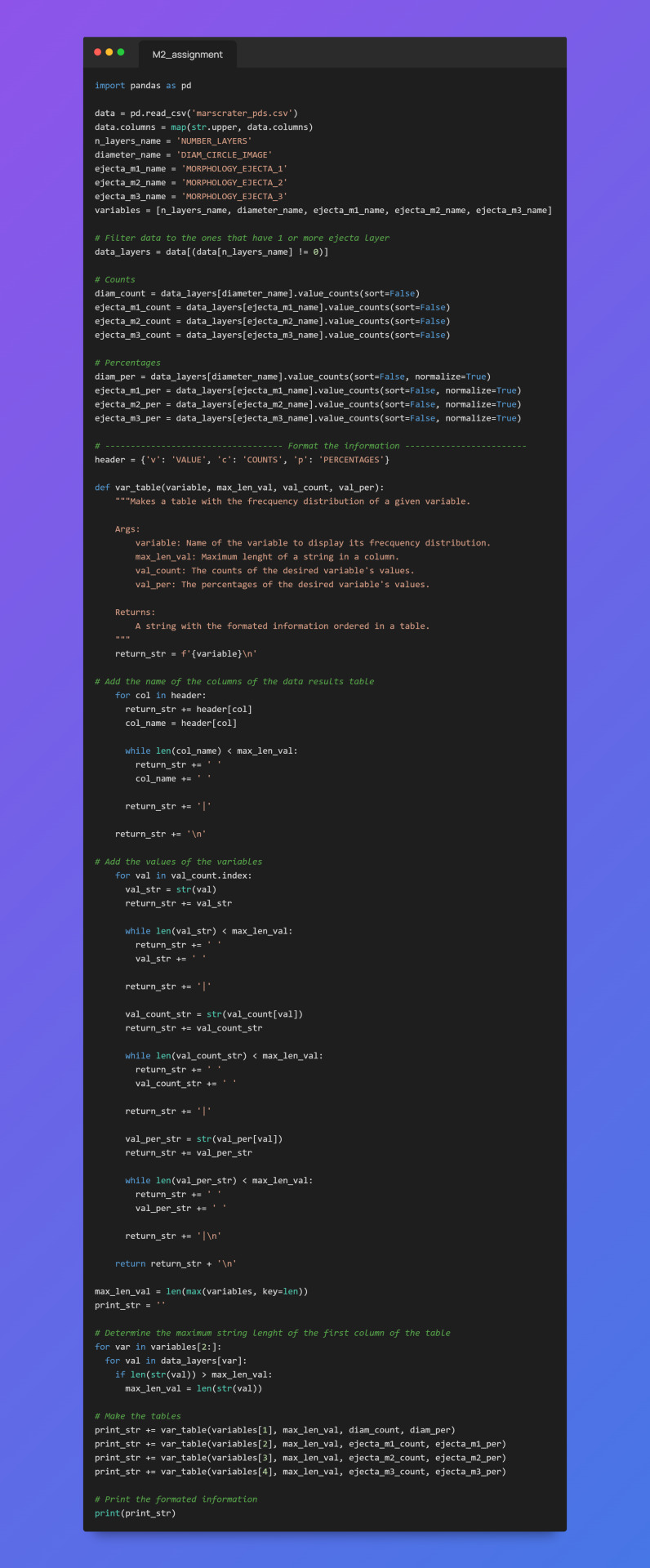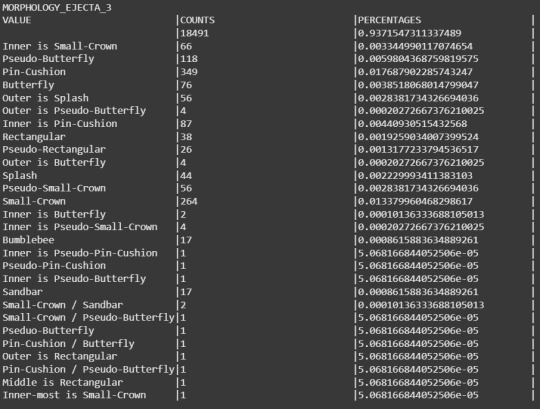Undercovering the secrets behind the martian surface.What they tell us about its past?
Don't wanna be here? Send us removal request.
Text
First steps: Frecquency analysis
On this following post, a python code is shown followed by come conclussions about the information gathered with it. The code used the imported module of pandas in order to conduct a frecquency analysis of the variables considered in the codebook made in the previous step of this research.

The code shown above takes the information from a csv file that contains the data base made by the scientist Stuart James Robbins.
The steps for the making of the frecquency analysis were the following:
Extract all the data of the csv file into a pandas DataFrame.
Filter the data using the variable NUMBER_LAYERS in order to create another DataFrame that contains only the information of the craters that contains 1 or more layers.
Use the built-in pandas function value_counts(sort=False) to get the counts of a variable´s values in the form of a pandas Series.
Use the built-in pandas function value_counts(sort=False, normalize=True) to get the percentages of a variable's values in the form of a pandas Series.
Store the given information in the previous pair of steps into separated python variables for variables, counts and percentages.
Format the given data into console printable tables for each variable, each table contains the name of the variable analized, the values, and its counts and percentages per value.
For this database and for our interest variables (crater diameter, and ejecta morphologies) the reuslt of the frecquency analysis is the following:




From the results we can start detecting some little things in the data.
For the variable DIAM_CIRCLE_IMAGE we can see that the best way to get some frequecy from it is by setting a range in where the craters diameters can be agrouped and then do a freqcuency analysis, because as it's shown in its results table, almost every crater varies in its exact diameter between each other, making this analysis practically unuseful.
In MORPHOLOGY_EJECTA_1 we can see some significant freqcuency distributions. At plain sight it can be proposed that most of the craters presents a single layer (this can be identified for the first letter of the values, S stands for single layer). Some of the values starting with a S reaches up to 20% in the frecquency analysis.
For MORPHOLOGY_EJECTA_2 we could propose that most of the ejecta blankets appears in THEMIS Daytime IR data as hummocky (first two letters of the value being 'Hu'). Also we can see that the type of ejecta blankets (debris distribution) we are interested the most in the research (Sp as the last two letters representing splash) are founded in a less frecquency conpared to other type of ejecta blankets.
In MORPHOLOGY_EJECTA_3 we can notice what type of variable it is, because this variable is used to describe only unique types of ejecta blankets that requires a separate clasification, thus why the majority of the values in this cariable is null. But one clasification we're fully interested in our research is the splash one, making this variable significant to this research.
Notes(Only MORPHOLOGY_EJECTA_3 is fully shown as the other 3 variables contains a lot of data and the post would be too large. The variable NUMBER_LAYERS is only used to filter data in the code, so no analysis for it is required).
0 notes
Text
Research Kickoff
For the following research, the database used is the one created by Stuart Robbins in his Mars study.
Research Questions
After looking at the Mars craters codebook I've been interested in studying the shape, (ejecta morphology), and its location.
The starting point is to get a relation for its locations. What I'm interested in is the analysis of the ejecta morphology and finding a region or pattern of its location. But, doing research about ejecta morphology and its importance in studying the martian surface I found that the location of fluidized ejecta blankets may be an indicator of subsurface volatiles (ice, water, etc.) which drives me to the following research question:
Is there an association between a crater's ejecta morphology (fluidized ejecta blankets) and its location in latitude and longitude?
The second topic chosen in relation with the first one is the association between ejecta morphology and crater diameter. This may be useful information about the martian surface and the kind of materials were on it during the impact event. This is being represented by the question:
Is ejecta morphology correlated with crater diameter?
Personal Codebook
DIAM_CIRCLE_IMAGE - Diameter from a non-linear least squares circle fit to the vertices selected to manually identify the crater rim (units are in km).
LATITUDE_CIRCLE_IMAGE - Latitude from the derived center of a non-linear least-squares circle fit to the vertices selected to manually identify the crater rim (units are decimal degrees North).
LONGITUDE_CIRCLE_IMAGE - Longitude from the derived center of a non-linear least-squares circle fit to the vertices selected to manually identify the crater rim (units are decimal degrees North).
MORPHOLOGY_EJECTA_1 - Ejecta morphology classified. If there are multiple values, separated by a "/", then the order is the inner-most eject through the outer-most, or top-most through the bottom-most.
MORPHOLOGY_EJECTA_2 - The morphology of the layer(s) itself/themselves. This classification system is unique to this work.
MORPHOLOGY_EJECTA_3 - Overall texture and/pr shape of some of the layer(s)/ejecta that are generally unique and deserve separate morphological classification.
Literature Review
With the help of artificial intelligence (Gemini) it’s how this literature review was started. The use of that tool was primarily for giving a simple overview of what ejecta morphology is in order to have enough information to continue the research in scientific papers for more detailed and supported information about ejecta morphology and the martian surface. From the information obtained when using the prompt ‘what is ejecta morphology’ the ai showed that ejecta morphology is the study and classification of the shapes and structures of material ejected during impact events, like meteor impacts on a surface. What it examines to classify these impacts is the form and patterns of the ejected material, including the shape of the crater, distribution of debris, and the presence of features like ejecta blankets, and multilayered structures.
Some of the principal ejecta morphologies can be broadly categorized into layered ejecta which is multiple players of debris deposited around the crater, radial ejecta consisting in material ejected along radial paths exhibiting a smooth path, lobate ejecta having a more irregular lobe-loke shape and a combination structures which is a combination of different types.
An important discovery made on the surroundings of the craters in Mars are the fluidized ejecta blankets. These are the lobate rounded edge layers of material surrounding an impact crater that looks like it flowed across the surface like a fluid rather than just being debris scattered by the impact. This ejecta, as the non-fluidized ones, can be encountered having one or multiple layers. The importance of that type of ejecta is what its presence on the martian surface implicates. Encountering these smooth shapes are a solid proof of the past or present presence of subsurface water or ice.
Ejecta units are the layers of debris expelled from an impact, the most extensive unit is the one that’s more far from the crater diameter. According to an article published in the Journal of Geophysical Research: Solid Earth [1] the maximum radial extent of fluidized ejecta blankets is demonstrated to be a function of both crater altitude and latitude. The most extensive ejecta units are located at low altitudes and high latitudes, while the least mobile ejecta (closest to the rim) is located at high elevations and close to the equator.
Another paper (conference paper) by NASA and the University of Arizona [2] recovered and analyzed some studies done to better understand the relationships between ejecta morphology and latitude, longitude, crater diameter, and terrain. The results suggest that subsurface volatiles (i.e., water, ice, CO2, etc.) influence the formation of specific ejecta morphologies. Ejecta morphology studies indicate that morphology is correlated with crater diameter and latitude. Even though some of these physical parameters are well predicted by existing ejecta emplacement models, due to inconsistency between other parameters and the models, more detailed models are necessary before the location of volatile reservoirs can be confidently predicted based on ejecta morphology studies alone.
Hypothesis
Based on the literature review made for this work, the proposed hypothesis between the two selected topics is that ejecta morphology is correlated with both location (latitude and longitude), and crater diameter, thus indicating the potential presence of subsurface volatiles.
Bibliography
[1] Mouginis-Mark, P. (1979). Martian fluidized crater morphology: Variations with crater size, latitude altitude, and target material. Journal of Geophysical Research: Solid Earth, 84(B14), 8011-8022. https://doi.org/10.1029/JB084iB14p08011
[2] Barlow, G. (1991, January). Martian impact crater ejecta morphologies and their potential as indicators of subsurface volatile distribution [Conference paper]. Annual Symposium of the University of Arizona/NASA Space EngIneering Research Center for Utilization of Local Planetary Resources 1991 Conference, Tucson, Arizona. https://ntrs.nasa.gov/citations/19910016705
[3] Google. (2025). Gemini (2.0 Flash) [Large Language Model]. https://gemini.google.com/
0 notes